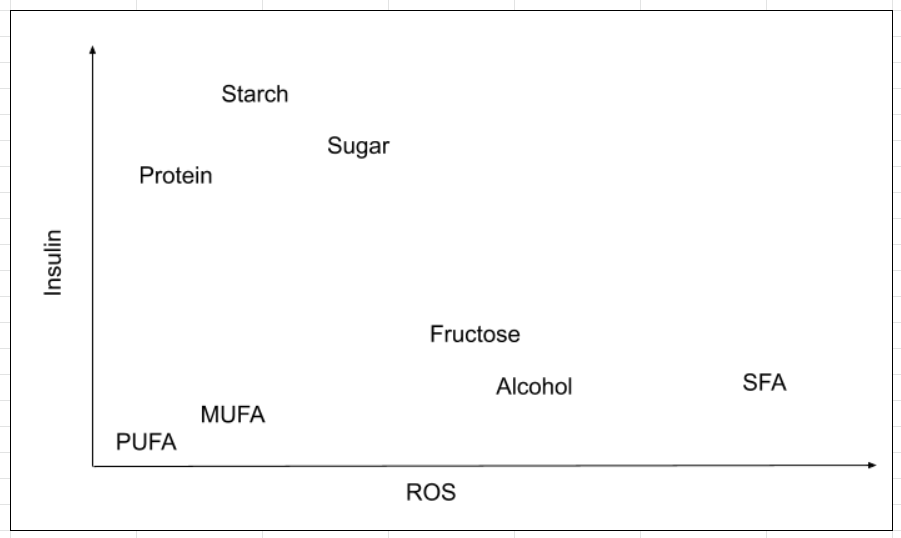
Much of the science behind The Croissant Diet and The ROS Theory Of Obesity is based on the interplay between insulin signalling and ROS production. The theory is that insulin is the signal to store fat and ROS blunts insulin signalling.
With that in mind I made this 2D graph of the different macromolecules, with my current understanding of their effects on insulin stimulation and ROS. The croissant diet is high in starch and SFA (saturated fat), so insulin will be produced but the signal will be blunted. This is, of course, the case in the the traditional French Diet and the French remained lean on it.
On the other hand, if you combine starch and vegetable oil (PUFA), you get maximum insulin product and maximum insulin signalling (very low ROS). This diet very clearly produces obesity, as is evident in the modern Middle East.

Why the highlight in fructose?
Fructose occurs along with glucose in foods.
And fructose along with glucose is sugar.
I’m not trying to highlight it, I just want to include all of the different types of things for people to think about. In include fructose because it behaves very differently from table sugar. The lack of glucose eliminates the insulin response and my understanding is that fructose also drives more ROS production.
Absorption of fructose alone without glucose is quite inefficient.
Precisely the reason why nature packages fructose and glucose together! (imo)
That’s very interesting. Nice visual, thanks!
So what is the macros I should keep for carbs and fats on this diet?
400 calories of carbs from potatoes and 400 calories from fat like cocoa butter or stearic acid enhanced butter is that perfect?
That was the ratio the mice were fed: 50:50. I tried to do more like 66:33. Which off the top of my head would be something like 700 calories of fat to 400 calories of potato.
Trying to make my own Steric Acid enhanced Butter. Can you share your recipe? I purchased The SA from Amazon and I understand the true % of SA varies.
If you cannot share your recipe can you tell me how I can know if I’ve added too much…I understand that can be dangerous.
Sure, don’t go over ~30% stearic, you’ll be fine. The available products are only ~50% stearic but we’ll be offering 90% pure stearic soon, check back in.
Got it.
Thank you sir.
If I have palm derived triple pressed stearic acid. Can I use it?
So do I mix in butter or coconut oil 80:20 ratio?
800 grams coconut oil 200 grams stearic acid?
Or coconut oil is not gonna do the work and I should use butter?
Interested in losing fat ASAP will report 🙏💓.
I don’t see any reason 80:20 coconut oil shouldn’t work.
Interestingly, enough I believe human breastmilk is 50 percent fat(mostly saturated) 45 percent sugar and 5 percent protein.
How do you view oatmeal as a starch? Would a 1/2 c of oatmeal with a tbls kerrygold and 4 tbls of heavy cream be an acceptable starch/SF ratio?
The ratio is right. Oatmeal does have more PUFA than other grains, but likely not enough to make a huge difference.
What about the fat in beef bone marrow? Is it as high in stearic acid as tallow or different?
I am astounded by the satiety and weight loss after 3 days and I was already at my best weight at 72 years old.
Excellent news on the rapid weight loss. How did you change your diet?
Interesting, according the cordain paper, marrow is very high in MUFA (monounsaturated – low in stearic acid). So maybe not the best for weight loss compared to backfat or dairy. I’m planning a post of further thoughts about MUFA in the near future so check back in.
What are your thoughts on higher protein intake for athletes and those that lift weights regularly? The literature seems to point about .8 g / lb of lean tissue per day being ideal.
There’s no doubt that athletes or people who are weight training need more protein.
I have tried keto and had good results mixed with bad side effects, and the amount of supplementing required to stay out of physical trouble made me think it was the right way for me to eat. However, there did not seem to be a carb that didn’t bother me. I started taking fairly high dose of thiamine about a month ago and now seem to be tolerating carbs. I am trying the Croissant Diet and hoping to be able to continue it.
I would like to ask, though, about this statement from your blog. ” The croissant diet is high in starch and SFA (saturated fat), so insulin will be produced but the signal will be blunted.”
If the signal from the insulin is blunted, does the insulin, and actually any remaining glucose, remain in the blood? I have read about this at Hyperlipid, but his writing is way over my head.
Thank you for the time and knowledge you have put into your blog. I appreciate it.
Actually, on reading my post, I see that I made an error and meant that keto is NOT the right way to eat for me.
In fact, most people (not all) have reported improvements in blood glucose control. In my opinion, and I’m going off of http://high-fat-nutrition.blogspot.com/2016/04/dairy-and-diabetes.html from Hyperlipid, the saturated fat increases first pass insulin response, which results in blood glucose being turned into glycogen rather than fat or hanging out in the bloodstream.
Does thus mean one can use some level of pure fructose as a sweetener?
Yeah, I mean, fructose can create fatty liver, but then again so can alcohol and I got away with plenty of that. So maybe?